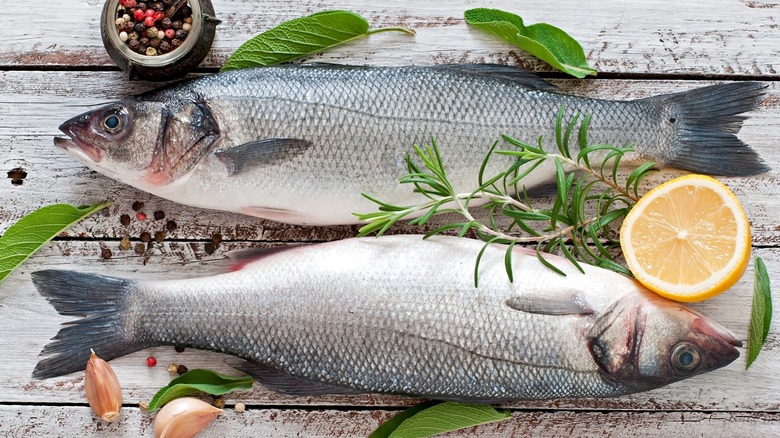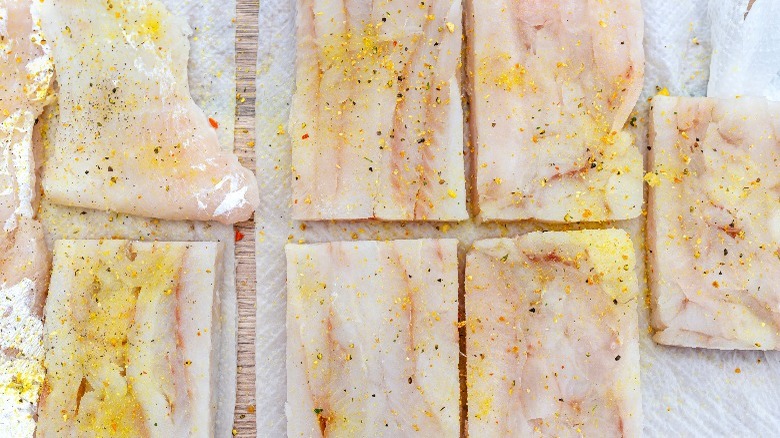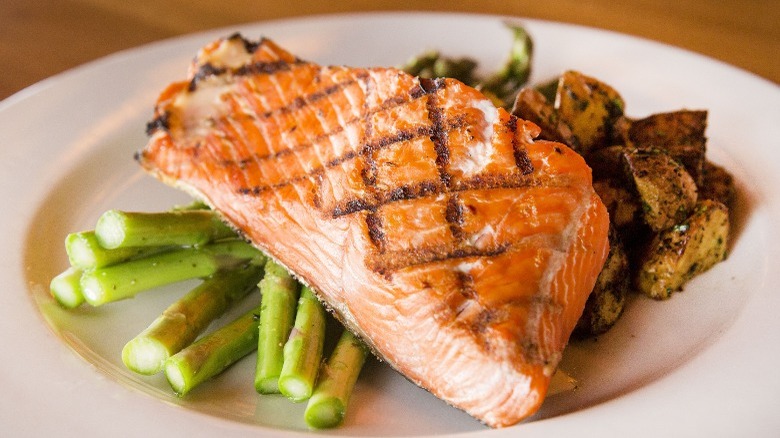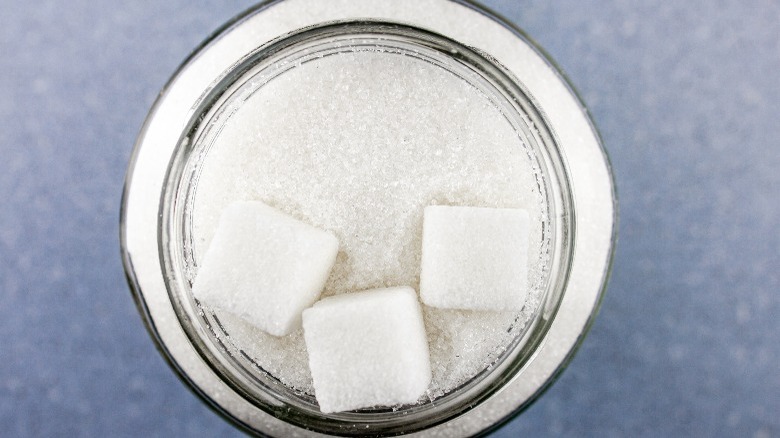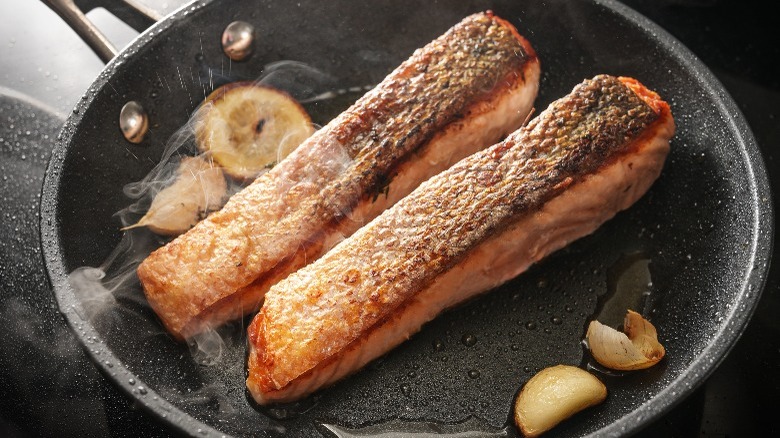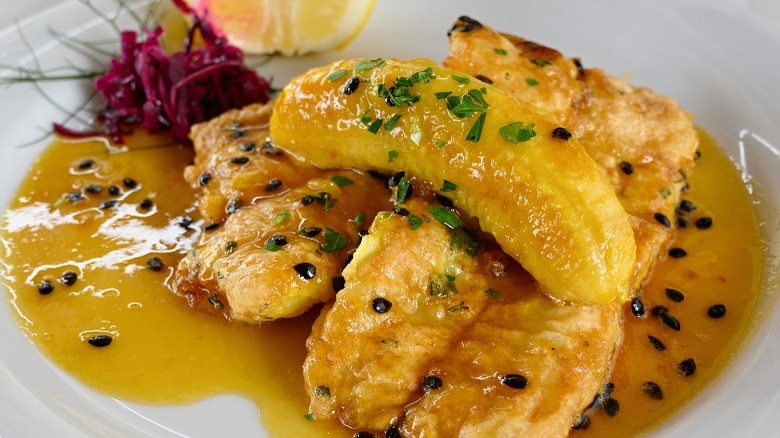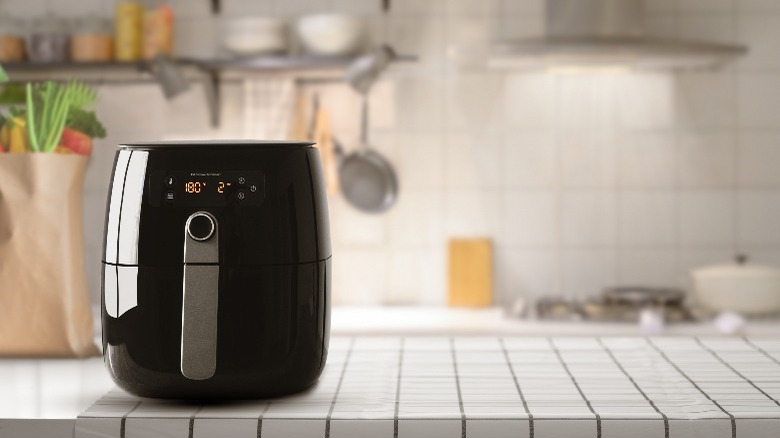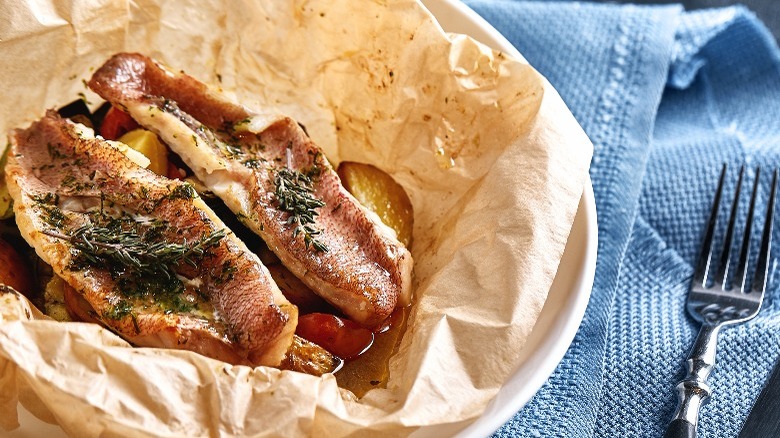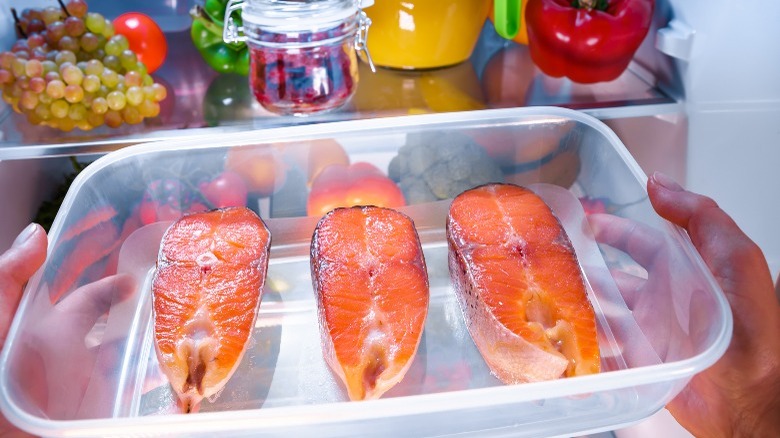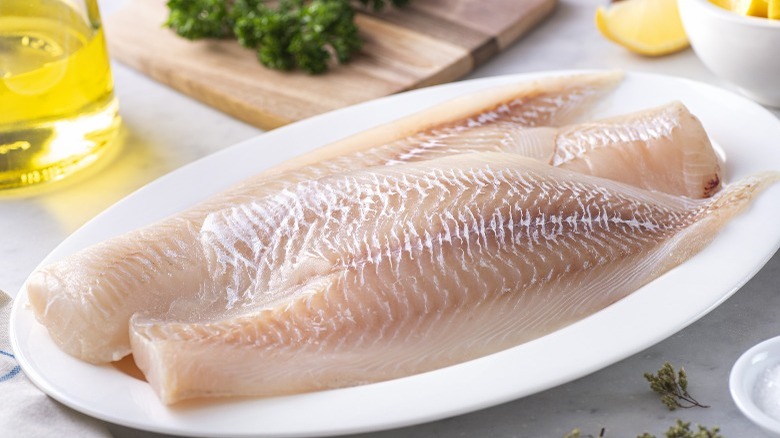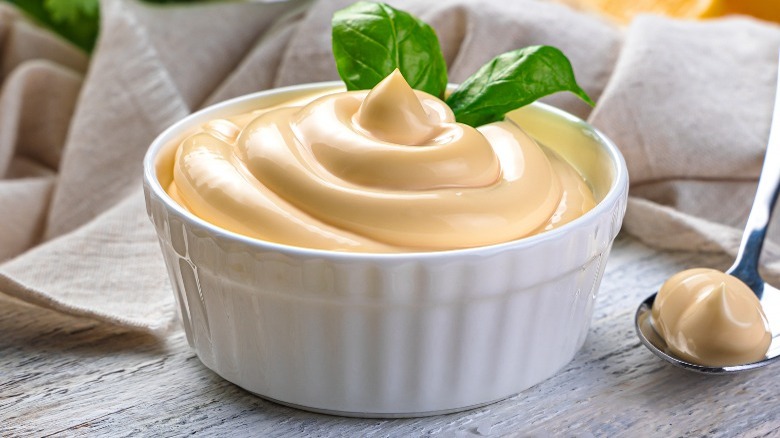15 Ways To Make Your Fish Taste So Much Better
Have you ever ordered fish in a restaurant, tasted it, and wondered why it's never as good when you make it at home? There are plenty of ways to make it taste better and some of them make immediate sense while others are a tad more nuanced. There's a lot more variety with fish as opposed to beef and chicken, so there's more room for experimentation.
Numerous types of fish can be baked, broiled, poached, grilled, fried, sautéed, canned ... you get the picture. But not all fish can be cooked in the same ways. It depends on the type, and they fall into two main categories. Fatty fish include salmon, mackerel, blue-fin tuna, and white bass. On the leaner side, you have flounder, red snapper, cod, halibut, tilapia, and other kinds of bass and tuna. Less fat means that lean fish can't stand up to as much heat without drying out; higher-fat fish have more inherent flavor and don't need as much added oil and seasonings.
Fish thickness also dictates the best ways to make it taste better. A delicate flounder, for instance, is not well-suited to grilling — and thick salmon can't be rolled up around asparagus.
Now that some of the basics have been covered, it's time to delve into the ways to bring out the best flavors and textures in home-cooked fish. Here are the important details that can push your seafood recipes closer to restaurant quality.
1. Pat it dry before cooking
Fish should be shiny and damp when taken out of a refrigerator, and then rinsed off to remove any contaminants. But it shouldn't be cooked when still wet, and this is a common mistake. The moisture must be removed from the outside, or the fish ends up steaming instead of searing. As a result, the texture will be kind of mushy after it's cooked.
After the fish is rinsed with water, place it on a plate and press into it with paper towels or a clean kitchen cloth until the outside feels dry. The inside will still be moist and flaky, and the outside will brown nicely when it's cooking. Do the pat-down once the fish is thawed and don't press down on the fish too quickly or with too much force. It still needs to get to room temperature before it's cooked, so more of the moisture will evaporate while it's waiting. Then, the fish or cooking vessel can be seasoned and you'll be ready to go.
2. Thaw it in milk
The two golden rules for not defrosting fish? Never let the fish sit out on the counter for hours. And just say no to microwaving. The first one can be hazardous to your health if the fish goes bad, and the results can't be guaranteed with the second — plus, it stinks up the inside. The smarter move is to take the fish out of the freezer the day before and put it in the refrigerator. When short on time, fish can be thawed in cold water that gets changed out every half hour.
Those last two tips are perfectly acceptable, although the cold water route can take away some of the fish's good taste and texture. This is where milk comes in. Frozen, uncooked fish can be removed from its packaging and placed in sealed bags or containers that get filled up with milk. That white liquid absorbs any unpleasant flavors and makes the fish more tender and subtly sweet. This one might seem strange at first but once you try it, you'll love how much better your fish tastes.
3. Prevent it from sticking to the grill
When fish sticks to the grates, it will quickly burn and leave a tough mess to clean up. But don't be intimidated by the thought of preparing freshly-grilled fish with those cool-looking crisscross grill marks. It's not as hard as it appears, as long as the fish and grates and prepared correctly.
The first step is to choose the right fish; delicate ones like halibut just won't work. Opt for a thicker, hearty fish and prepare the grates while it is coming to room temperature. If the grates weren't cleaned the last time, fire up the grill and use a grill brush to clean it off. The grates and fish can be brushed with mayonnaise or cooking oil — for the latter, choose one with a high smoking point or the grill could flare up. Cooking spray can also be used on the grates, as long as they aren't hot and susceptible to flaming up.
Fish will cook fast, so don't walk away to answer a text or walk the dog. It should only be turned once with a clean metal spatula — to get the grill marks, first place the fish down diagonally on the grates at 2 and 8 o'clock. When it's flipped, place it at 10 and 4 o'clock. Remove it from the grill carefully cooked, and voila! A piece of fish that tastes and looks amazing.
4. Sweeten it up
Sugar on fish? Yes, yes, a thousand times, yes! When used the right way, it creates a sweet coating that enhances savoriness or even sourness that you combine with it. Or, it can be used on its own on both sides. About a 1/2 teaspoon of white sugar is enough for 1 pound of fish. It gets lightly sprinkled on just one side and cooked with that side down — the second side doesn't need to be sugared after it's flipped.
Like salt, sugar draws excess moisture out of fish and improves the taste and texture. If you don't want to go the sugar-only route, just incorporate that or honey in a small bowl with things like lime juice, garlic, salt, and chili powder. The sugar's sweetness can be balanced out with the other ingredients and if you're not sure, just take a small taste first. You can marinate the fish in the mixture, or just brush it on while the fish is cooking. Keep a close watch if you use honey, any that drips into the pan can harden and burn.
5. Put lemon slices on it before baking
Any restaurant that serves fish will have lemon slices or wedges on those plates. When the lemons are good and ripe, the juice comes out easily and adds the perfect tang. But lemons can also be placed with raw fish for cooking. The bottom of a cooking pan can be linked with sliced lemons and the fish gets placed on top. Then, lemon zest can be combined with melted butter and fresh garlic and poured on top.
The lemon slices can also be put on top of the fish, and this only needs to get baked for 15 to 20 minutes. Either way, the flavor will get into the fish, and you can squeeze hot lemon juice onto the fish from the slices. The key here is to use the freshest lemons possible. Look for ones that are a true yellow, instead of overly bright, which is a sign a lemon's not ripe. It should have a soft texture but no spots. And don't use bottled lemon juice unless there's no other choice, because it doesn't taste as fresh.
6. Don't marinate it in lemon juice for too long
Many kinds of fish only need a simple marinade made with fresh lemon juice and some coarse salt. The fish will be perfectly seasoned and won't need anything else except maybe a sprig of fresh parsley. But even though fresh lemon juice is a common fish-marinating ingredient, sometimes things go too sour. Lemon juice is acidic – if the fish soaks in it for too long, its texture will change and the flavor will be too tangy.
Just 15 minutes in a lemon bath is all that fish needs to absorb the flavor, and the same is true with lime juice. When fish sits in citrus marinades for much longer than that, the acids start working on the fish and you end up with something like a ceviche. There's absolutely nothing wrong with this marinated raw fish appetizer but you probably weren't going for that with a simple flounder and lemon juice marinade. After 15 minutes or so, discard the juice and cook the fish as usual.
7. Think out of the box
Circling back to the more unusual ways that fish can be prepared, chefs have been exploring fish recipes since the dawn of time and you may have enjoyed things like fish tacos. Nothing could be easier — cooked, breaded, or unbreaded fish pieces get put inside taco or tortilla shells and enhanced with avocado, salsa, garlic, lime juice, cabbage, and other ingredients. But restaurants in the United States have been making them for decades and other countries like Mexico were doing it way before that.
Smoking fish is also an older method — if you've never tried it at home, it'll be something new and exciting. This can be done with an outdoor smoker, of course, but you can also smoke fish in a conventional oven. To do that, prepare a whole fish (trout comes to mind) by marinating it in water, salt, and spices for up to 24 hours. Then, it can be rinsed off and patted dry. Look for flavored wood smoking chips (hickory and apple are two good choices) and layer them in an oven-safe or smoker container. Place the fish on a rack and set that on top of the container. This gets cooked on low heat for about two hours — then the heat gets turned to high for roughly 20 minutes. For indoor smoking, keep the windows open or turn on the fans.
8. Don't remove the skin before cooking
Some people remove fish skin because they don't want the extra fat, don't appreciate the taste, or both. Fish is known to be a healthy food because it contains vitamin B12, minerals, and omega fatty acids. This can promote brain function, decrease the risk of heart disease and provide other health benefits, and much of those good fats are in the skin. When it gets heated up, the flavor and nutrients get into the fish and also make it taste better.
Fish is easier to cook when the skin is left on, too. It can be placed skin-down next to the heat source and doesn't even need to be flipped. The skin holds the fish together, which makes it less likely to fall apart. But if you want the skin to brown perfectly, don't cook it in a nonstick pan — carbon steel and cast iron work best. If you prefer not to eat the skin, simply take it off. It usually detaches easily in one piece, especially after it's been browned and crisped.
9. Be bold with meaty fish
Meaty fish like swordfish and tuna don't need a lot of accouterments but they can stand up to bold flavorings. Feel free to experiment with soy sauce, flavored oils, and less-used spices in your cabinet. There's no reason why you can't sprinkle avocado oil, ginger, cumin, and lemon pepper on hearty fish. Or, add even more punch with a sauce or relish made with shallots, capers, olives, or salsa.
Meaty fish can also take a full-flavored marinade made from just two ingredients: maple syrup and whole-grain mustard. And for a Thai-inspired taste, experiment with marinade ingredients like fish sauce, lime juice, coconut milk, and red chili flakes. Thick fish can even be treated like cuts of meat and prepared with broth and fruit or a red wine sauce. But whenever trying new recipes like these, make a small amount first and taste it — the ingredients might need to be adjusted.
10. Switch from pan-frying to air-frying
Fresh fish and microwaves don't go together but the same can't be said about fish and air fryers. These incredibly versatile appliances fry food without all the added oil and calories, but what comes out tastes just as good or even better than pan-frying. It's the perfect way to fry fish and also saves you the trouble of having to clean up all the extra cooking oil — these gadgets let hot air do most of the work. The fish ends up with a nice, crispy texture on the outside and moist, firm flesh inside.
The fish still gets breaded, so it will have more carbs than with other cooking methods. To make basic air-fried fish, dip it in flour, beaten eggs, and breadcrumbs just like you would for pan-frying. Once the air fryer is heated to 400 degrees Fahrenheit, the fish gets cooked for six minutes per side. That's it! You can also skip the breading and cook the fish for about the same amount of time, but remember to season it first.
11. Envelop it in parchment paper
Too much moisture on fish leads to unwanted steaming but that doesn't mean fish can't be cooked this way. The proper way to do it is en papillote, the French term for "in parchment." It can be done with tin foil instead of parchment paper, but the latter is usually more expensive by the roll or sheet.
The en papillote process works best with delicate fish like flounder and Dover sole, since it gets wrapped up. The sheet should be about 18 inches long and the oven gets heated to 400 degrees Fahrenheit. The fish, seasonings, and lemon slices get placed on the sheet, but feel free to add fresh herbs and thinly sliced vegetables like asparagus as long as the cooking time is the same. Vegetables like sweet potatoes and Brussels sprouts take longer to cook than delicate fish and might not be soft enough — fish like this usually only needs about 15 minutes.
Once the ingredients are in all the pieces of parchment or foil, fold up each one carefully and crimp the edges to prevent leaks. These can be placed seam-side down on baking sheets. Be careful when opening them up, because the hot steam will escape.
12. Store it properly
Fish tastes best when fresh, but catching it and cooking it on the same day isn't doable for most people. Storing it properly isn't complicated. Feel free to ask the fishmonger when the fish was caught because it might have been previously frozen — refreezing might not be recommended. And if you're buying frozen fish, check to make sure that the package isn't torn or damaged.
FoodSafety.gov explains that fresh fish should only have a mild smell without any fishiness or sourness. It should be refrigerated or placed in a freezer within two hours of purchase — never leave it sitting outdoors or in a car when it's hot outside. Fresh fish must also be eaten within two days of purchase, and stored at 40 degrees or lower. It'll be fine in a plastic container — to keep it even colder, however, place it in a plastic bag on top of a bowl of ice in the fridge. But if it won't be used within that time, wrap it in moisture-proof paper or plastic, place it in a freezer-safe bag, and freeze it.
13. Bring it to room temperature before cooking
Fish needs to be kept cold until mealtime rolls around but it's important to bring it to room temperature before cooking. Cold fish that gets put into a hot pan or another heat source won't cook evenly — the outside might be browned and dry and the inside could still be raw, cold, or even frozen.
This doesn't mean that partially frozen fish should thaw out on a counter. It can sit out for up to two hours in cool and moderate temperatures, but only one hour when the temperature is 90 degrees Fahrenheit or higher. But there's usually no reason to leave fish out for that long before cooking. Bacteria grow fastest when the temperature is over 40 degrees Fahrenheit — and why would anyone want to risk contamination? To stay on the safe side, give the fish about 20 minutes to get to room temperature before cooking.
14. Don't be afraid of mayonnaise
Mayonnaise is one of the most versatile ingredients in a kitchen — besides using it to grease fish for grill grates, it can be a delicious glue for tasty toppings. Mayonnaise is fat but in a thicker form and it works on leaner and fatty fish. Regular and low-fat are fine and a large amount isn't needed to do the job, especially on fish with higher fat content.
A thin layer of mayo can be brushed onto fish with a basting brush, and then topped with spices, bread crumbs, sesame seeds, or crushed nuts. Feel free to play around with this by adding 1 tablespoon of mayo into a small bowl and mixing in fresh parmesan, Dijon mustard, and fresh parsley. That's good enough on its own, or sprinkle on toppings. This can be cooked at 400 or 425 degrees Fahrenheit and will be ready in no time. Turn on the broiler for a few minutes and that topping will turn into an amazing, crispy crust.
15. Get the timing right
Fish generally cooks faster than meat and poultry and must reach an internal temperature of 145 degrees Fahrenheit, according to the Mayo Clinic. The best way to check this is with a food thermometer, which should be stuck into the thickest part of the fish. You can also use a fork to check the fish for flakiness; if it's translucent, it has not finished cooking. Always stay near the oven, stove, or grill when fish is cooking since leaving it on even a bit too long can leave you with a dried-out or burnt mess.
When sautéing fish, heat up a small amount of oil or butter in the pan and give the fish just five minutes per side. Deep-fried, battered fish cooks even faster in hot oil. Thick fish cooked on heated grills needs about the same amount of time per side, and oven-baked fish can be prepared at 400 to 450 degrees Fahrenheit, depending on the type of fish. The general rule here is to cook it at 10 minutes for each inch of thickness, but thinner fish baked in sauces will take longer.
